Compressed Face Powders
As more women began to powder their faces in the early twentieth century and found the need to ‘touch up’ during the day, they were confronted with the problem of carrying powder around in their purse or handbag.
Portable metal containers for carrying loose powder had been around since the 1890s – women who could afford it might also have their jeweller work up something suitable – but some women simply repurposed other containers – such as a pill boxes, cigarette cases and snuff boxes – or carried powder around tied up in a bag made of leather, silk or some other fabric. As using face powder was not completely accepted these early containers were small and discrete, or were disguised so that they were not what they appeared to be at first glance.
See also: Loose Face Powders
Early loose powder containers suffered from a number of issues – bulkiness, the need for frequent filling, as well as leaks and spills – all of which were sources of annoyance. So, in the 1920s, when wearing make-up became more fashionable, women became increasingly vocal about the problem.
Twenty years ago, loose face powder, in a fancy metal box, would have been a novelty and would have enjoyed a limited sale, no matter how big or awkward the size; but to-day, in this advanced Twentieth Century a woman knows what she wants and will have it. She follows the line of least resistance and will not burden herself with an added task of filling or spilling a box full of loose face powder preparatory to the conquest she is about to embark upon. This does not happen once a week, but once or twice in each and every day. What woman will be a slave to the whim of a mere novelty box man or any other kind of man?
An Easter ensemble, including a coat, or a Paris or an American gown, is far too costly and attractive to be spoil by just one little spill.
Out great-great-grandmothers lived under such handicaps, but thank goodness not the woman of the glorious to-day!
The up-to-the-minute woman longs for daintiness, attractiveness, charm and real beauty in everything she handles and that is part of her personality.
So: Big, Clumsy, Complicated, Loose Face Powder Box: Beware!!(Campbell La Barre, 1925, p. 140)
Given the troubles they had with the containers, some women abandoned the idea of carrying loose powder around and turned to solid or compressed powders instead.
Compact, compressed and cake powders
Compact powders have gone by many names over the years with cake and compressed being the most common alternatives in the English-speaking world. This was not the same elsewhere. In 1914 Houbigant first used the term ‘poudre comprimée’ to mean compressed powder but the terms ‘poudre solidifiée’ (Klytia), ‘poudre compacte’ (Dorin) or ‘poudre concrète’ (Roger & Gallet) were also used in France. Some of these terms were also applied to compact rouges but I will only look at face powders here.
To keep things simple, I am going to restrict the use of the term ‘cake’ to those face powders that required a wet sponge to apply them, best exemplified by Max Factor’s Pan-Cake and generally defer from using the word ‘compact’, as it came to apply to the powder container – whether it contained loose, compressed, cake or any other form of powder – rather than the contents alone. I am also going to refrain from discussing the newer forms of ‘pressed cream’ powders that became popular in the 1950s, as these also acted as foundations and their formulation differed from those made before the war.
See also: Pan-Cake Make-up and Cake Make-up
Qualities
Until the introduction of Pan-Cake make-up in 1938, most compressed face powders were essentially loose face powders compacted into a ‘tablet’ or ‘pastille’; other names used in the trade included ‘block’ and ‘brick’. This meant they were made from ingredients similar to loose face powders and manufacturers tried, as best as they could, to produce a compressed powder that also had similar qualities. This was easier said than done!
The chief problem was the tablets. They had to be thin if they were to fit into a small portable container but this made them liable to crack or break when rubbed with a powder puff. For early manufacturers, making a tablet strong enough to resist flaking, breaking or crumbling, generally came at the cost of coarsening the powder or increasing the difficulty the puff had with lifting the powder, i.e., they had a low ‘pay-off’.
Binders
The simplest way to strengthen a compressed powder was to add a binder to bond the powder together. The trick was to make the binder strong enough to ensue that the tablet would remain firm but weak enough to enable the powder to be easily lifted off the surface of the tablet with a puff.
Manufacturers used a wide range of materials as binders. As well as gum mucilages (e.g., tragacanth, karaya, arabic, quince seed and carragheen), sugars, aromatic tinctures and soaps were also used in assorted combinations. As there was a close relationship between the binder ingredients, the amount of binder used, and the composition of the powder, the determination of the final binder formula was generally arrived at by trial and error. Two recipes for binders are given below:
½ oz. finest powdered gum tragacanth.
2 ozs. isopropyl tinct. benzoin 1 in 10.
Distilled water to 80 fl. ozs.(Odoro, 1923, p. 445)
No. 1694
Tragacanth 10 Tincture of tolu 25 Tincture of styrax 5 Distilled water 1000 (Poucher, 1932, p. 565)
Binders in one form or another were a common component of early compressed powders but as the years progressed, and powder and compression technologies advanced, the general industry trend was to reduce the amount of binder. By the 1930s there were a number of compressed powders on the market that used no binder at all (D&CI, 1938, p. 539). These low-binder or binder-free, compressed powders were softer than earlier forms and had a better pay-off.
Puffs
A good deal of pressure was required to lift powder from the tablet so it was virtually impossible to use a ‘swan’s down’ puff (actually made from gooseflesh). Puffs made from chamois, lamb’s-wool or cotton (e.g., velour) were used instead, with synthetic materials coming into play at a later date. These were not as soft as down but they had advantages. They were less likely to spill powder on clothing and they could also be made very thin to fit into a small compact.
Manufacture
When making a compact powder, manufacturers could elect to make tablets by casting them wet into moulds, or use a mechanical compressor, methods that were also used in the manufacture of rouge. As wet moulding or casting did not required expensive machinery it was popular with small cosmetic firms that made products largely by hand but larger manufacturers generally avoided it and used either damp or dry compression. I include a description of the wet moulding method although compact powders made this way cannot be considered to be ‘compressed’.
As mentioned earlier, compact powders made before the Second World War used formulas that were similar to loose face powders of the day. They generally contained a high percentage of talc, as it compacted very well, but the amount of talc was usually limited to less than 50% of the mixture as more would increase the risk of the tablet cracking (Thomssen, 1947, p. 66). If the wet moulding method was used, starch in the mixture would add strength to the tablet by partly gelatinising during the mixing process, thereby acting as a binder. However, care had to be taken not to overload the mixture with starch as this would make the powder too hard and reduce transfer to the puff (Winter, 1932, p. 616).
Wet moulding or casting
In the wet moulding process, the powder was made into a paste which was then poured or forced onto a shallow glass, porcelain or metal mould (godet) to form a tablet. It was a common practice to mix in a small amount of plaster of Paris when making powders of this type. This added strength but the resulting tablets were generally of poorer quality. The presence of plaster made the powder harder to lift from the tablet, and the powder felt coarser when applied to the skin.
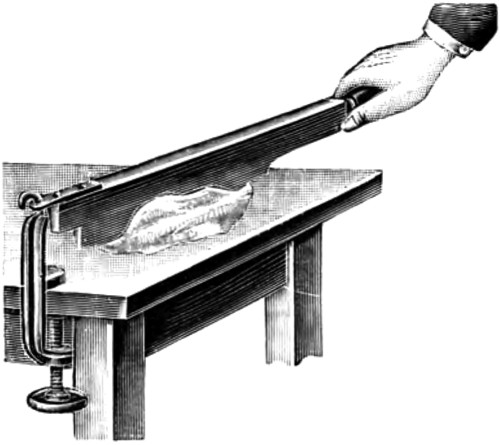
Above: An early kneading device used to mix up a thick paste (Winter, 1935).
After they were dried, the tablets were either glued directly into the container base or more commonly stuck to pieces of metal or glass, which were then glued into the container.
The wet type are made into a fairly damp paste, which is moulded in a glass or porcelain shallow capsule about 1¼ inches in diameter. The blocks are then dried at normal temperature in a current of air. If undue heat is applied they will split, and apart from this the perfume will be damaged. During the drying operation the compacts are stood on blotting paper to absorb any excess of moisture. When dry they are trimmed with a special rotating knife which gives a perfectly smooth finish to the surface. They are afterwards stuck on to pieces of glass, which are then glued to the bottom of the container—some kinds are fasten direct into the base of the box. a small puff is generally included with the package ready for sale. This wet type of compact is very much out of date, but still adhered to be certain makers.
(Poucher, 1932, p. 567)
The wet casting process consists of making a wet, heavy paste of all the ingredients. The paste is poured or pressed by rolling into lubricated nickel molds, in which the cakes are allowed to dry. Just before putting the molds into the dryer, dextrin or gum arabic adhesive is painted over the surface … and glass, porcelain or metal plates, properly shaped, are pressed down on the glued surface of the cakes. When the cakes are dry they adhere to the plates.
(Thomssen, 1947, p. 65)
The selection of the glue was very important. It needed to have good adhesion, preserve well and not interfere with the perfume, e.g., a resin-water-glass glue. Early forms were often unsatisfactory and the tablets were prone to come free with use.
Damp and dry compression
The first compressed powders made with mechanical presses were presumably made using a hand or foot press. These had previously been used to make pills and other products for the pharmacy trade and I imagine that the first machines used to make compressed face powders were developed from these.
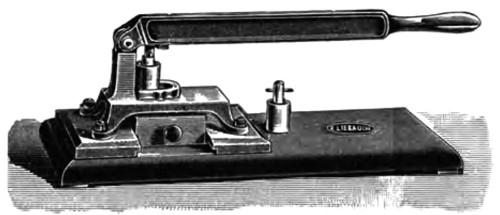
Above: An early hand press for making tablets (Winter, 1932, p. 345).
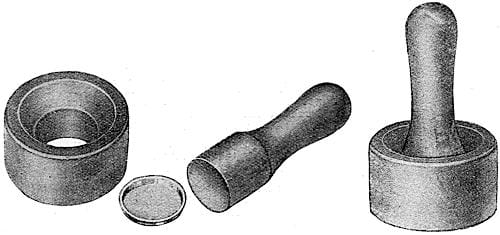
Above: Design for a hand press made from hardwood that could be used by a pharmacist to make compact powders. A glass or metal godet coated with liquid glue is place at the bottom of the cylindrical block. After the powder is poured in, the pestle is inserted and given a light tap. The compressed powder is then removed and left for a couple of days to dry before being inserted into a container (Redgrove, 1932).
Larger manufacturers used automatic mechanical compressors.
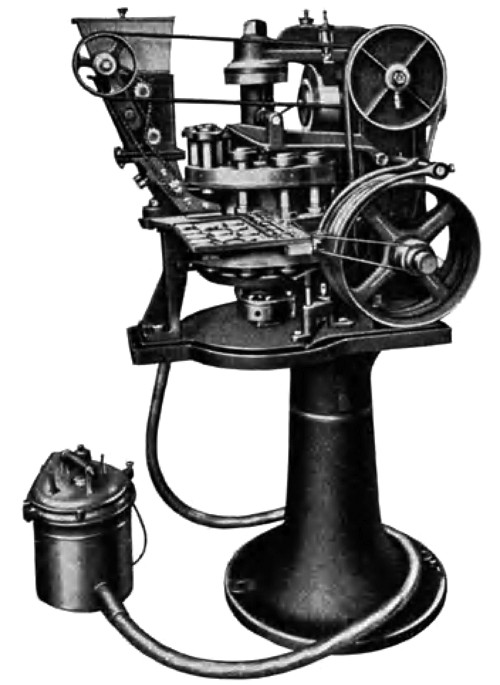
Above: An early automatic tablet machine (Winter, 1932, p. 346)
The exact compression method a manufacturer used depended on the powder formula, particularly on the binder type. If an aqueous binder was used then the method was referred to as wet or damp compression, if the binder was dry then the process was known as dry compression.
Typical Formulae
Damp Compression Method
per cent. Talc Italian 40.0 Zinc oxide 20.0 Zinc stearate 8.0 Rice starch 10.0 Magnesium carbonate 10.0 Kaolin, extra fine 12.0 Dry Process
per cent. Kaolin 20.0 Zinc oxide 15.0 Precipitated chalk 25.0 Talc 32.0 Compact binder (e.g. soap) 8.0 Perfume q.s. Colour q.s. To the former base suitably coloured, sufficient binder is added to give a stiff paste. It is then stamped out and allowed to dry under carefully regulated conditions. The latter is compressed directly.
(Harry, 1944, p. 121)
In both damp and dry compression the amount of pressure used to create the tablets was critical. If the powder was compressed too lightly it would be too soft and likely to crumble, but if too much pressure was applied, the surface would become glassy and it would be hard to lift the powder off the tablet with the puff. Trials were needed to determine the optimum pressure required for each formulation.
One adverse result of the pressing process – caused by the powder particles sticking together – is that the average particle size is larger in a compressed powder than in loose. This needed to be controlled. If the particles got too large they would coarsen the powder and make it feel harsher.
A more serious problem was the introduction of air pockets into the tablets that could cause the tablet to crack or break. To help control this, the powder could be vigorously shaken before it was compressed to dislodge any larger bubbles of trapped air, and then a moderate pressure first applied to the tablet to squeeze out any remaining air pockets, so that none would remain when the tablet was fully compressed. More advanced compression machines could be set to do this automatically.
It is possible to make a free standing tablet using a compressor, but most manufacturers elected to compress the tablets directly into shallow metal trays (godets) so that they could be inserted directly into a compact case by means of a clip, spring, or some other mechanism. This reduced the risk of the compressed powder tablet cracking or breaking before it was sold and also made replacement of the tablet in a compact a lot easier. Patents for inserting godets into compacts appeared as early as 1917.
Putting the powder into the godet was an advance but getting it to stay in the godet proved a problem until it was discovered that sloping the godet wall inwards over the tablet would do the trick. Unfortunately, as the powder was used up, the sharp, inward-pointing edge cut into the puff, eventually making it unusable (Ashton, 2012, p. 115).
Colour
Like the other powder constituents, the colours used in compressed face powders were the same as those for loose. However, because the powder was presented differently some adjustments had to be made.
Loose face powder looks darker in the box than it does when spread on the face but after a while women learnt to match the colour of the bulk powder with their skin tone. However, when face powder is pressed into a tablet its smoother surface, with a higher reflectivity, makes the powder look paler and less attractive in comparison with the same shade of boxed loose powder.
One way to ameliorate this was to roughen up the surface of the tablet by putting a piece of fabric between the powder and the press, or to mechanically abrade the surface after the tablet was made. A small amount of oil – such as that contained in the powder perfume – was also useful as it would darken the tablet slightly.
Compacts
The first metal compacts were made in Europe. They were large and awkward and referred to as ‘trunks’ or ‘puff boxes’ by some. Over the years they got smaller and more elegant. In the English-speaking world they were largely known as ‘vanities’ but, by 1925, the container was also being referred to as a ‘compact’ (Ashton, 2012), a name which stuck. In the early 1930s ‘Flapjack’ compacts became very popular. At 100mm in diameter they were up to twice the size of previous compacts. They were originally designed for use on dressing tables (Larison, 1933, p. 637), but women started carrying them around to take advantage of the larger mirror and increased powder source.
Pressed powder compacts were popular, and technical advances meant that compressed cakes became softer with a better payoff – allowing the use of softer puffs – but they continued to have issues. For example, as the centre of the tablet was worn away by the puff, a rim of compressed powder would be left around the edge which would soon break into pieces, rendering the tablet unusable.
Compacts containing loose face powder also underwent developments. Improved machine tolerances meant that lids and other parts fitted more snuggly, while advancements, first in metal and then fabric filters, improved the delivery of loose powder to the puff. Progress in these areas meant that by the 1930s women could carry loose powder in a compact with little risk that it would spill.
Looking forward from 1935 it would have been difficult to predict whether the loose or the compressed powder compact would become dominant, and some manufactures hedged their bets by making interchangeable compacts that could accommodate both types of powder. Ultimately neither loose nor compressed powder compacts would hold first position. Their decline began with the release of Pan-Cake make-up in 1938 and continued after the Second World War with developments in cake make-up, pressed cream powders, liquid make-up and so forth.
See also: Liquid Face Powders
First Posted: 27th January 2014
Last Update: 5th January 2025
Sources
Ashton, M. (2012). A compact history of face powder containers. Volume three: Compressed powder. Winchester, UK: Mike Ashton.
Campbell La Barre, E. (1925). “The loose face powder bogy” as seen from a feminine viewpoint. The American Perfumer & Essential Oil Review May, 140.
Harry, R. G. (1944). Modern cosmeticology (2nd ed.). London: Leonard Hill.
Hibbott, H. W. (Ed.). (1963). Handbook of cosmetic science. An introduction to principles and applications. New York: Pergamon Press.
Larison, R. H. (1933). The lipstick and the compact. The American Perfumer & Essential Oil Review. February, 637-639.
Odoro. (1923). Face powders and talcums. The Perfumery and Essential Oil Record December, 442-446.
Poucher, W. A. (1932). Perfumes, cosmetics and soaps (4th ed., Vols. 1-2). London: Chapman & Hall, Ltd.
Redgrove, H. S. (1932). Small-scale manufacture of compacts. The Chemist and Druggist. June 11, 644.
Sagarin, E. (Ed.). (1957). Cosmetics: Science and technology. New York: Interscience Publishers, Inc.
Thomssen, B. S. (1947). Modern cosmetics (3rd ed.). New York: Drug & Cosmetic Industry.
Winter, F. (1932). Handbuch der gesamten parfümerie und kosmetik. Vienna: Julius Springer.

1929 Norma Shearer ‘touching-up’ on the set of ‘The Last of Mrs. Cheyney’.
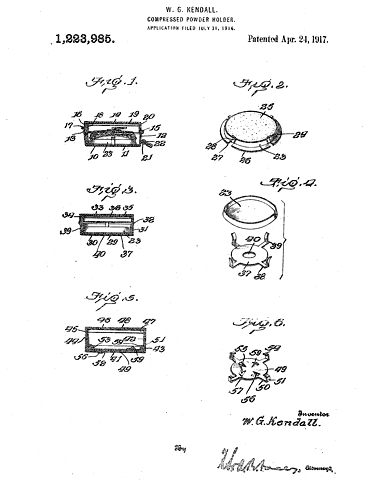
1917 Patent for a clip to hold a compressed powder in a compact.

1917 Dubarry Powdrette. This solid, portable face powder was not made using a compressor.
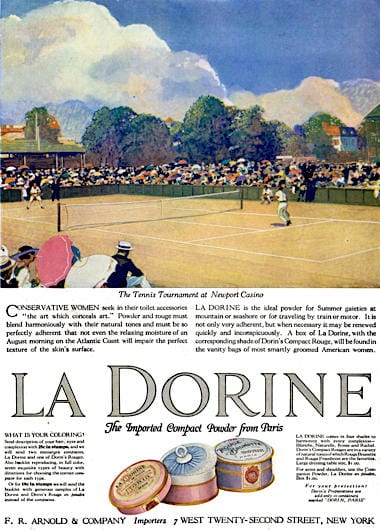
1919 La Dorine Compact Powder.
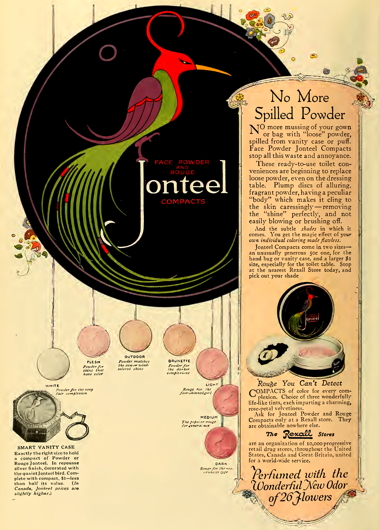
1921 Jonteel compressed powder. Shades: White, Flesh, Outdoor, Brunette, Light, Medium, and Dark.
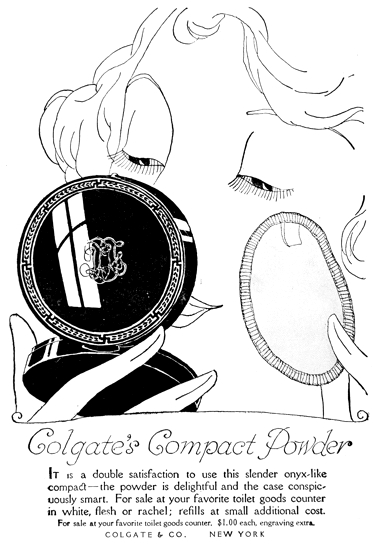
1923 Colgate Compact Powder.
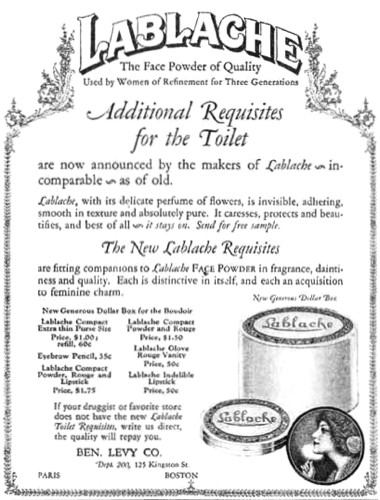
1924 Lablache Toilet Requisites including Lablache Compact Powder.
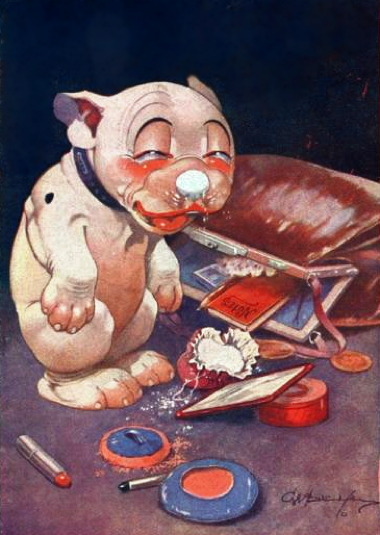
1924 This comic postcard includes some loose powder containers used in the 1920s. The one at the front appears to be a Beaverpuf. Made from leather it had a fitted lid that also served as a powder puff.
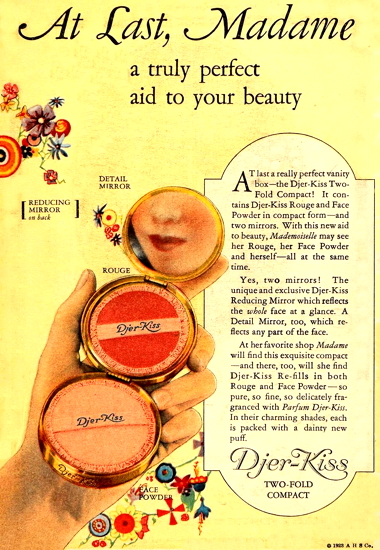
1924 Djer-Kiss Compact Powder and Rouge..
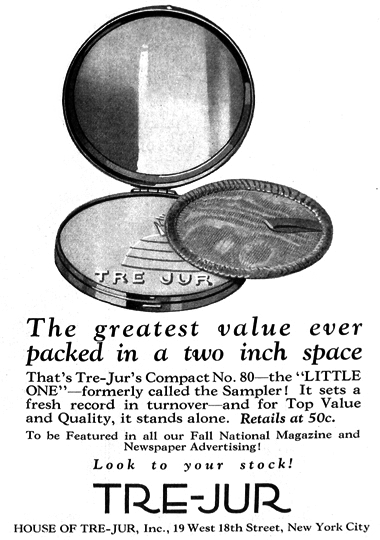
1926 Tre-Jur Compact Powder.

1926 Roger & Gallet Compact.
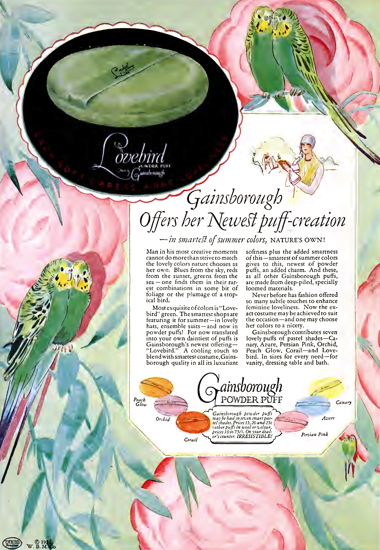
1926 Gainsborough Powder Puff.
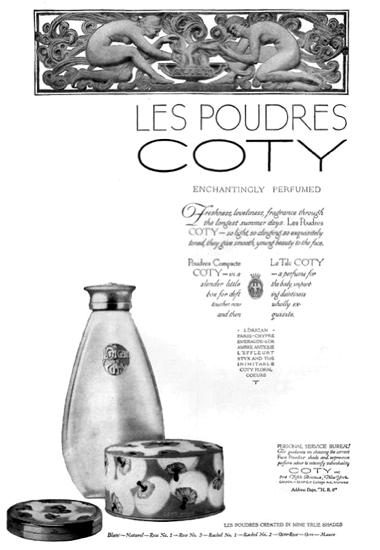
1927 Coty loose and compressed powders.
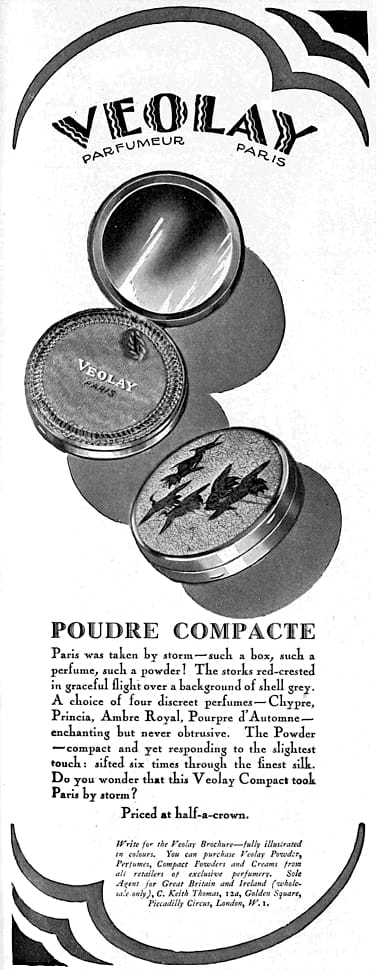
1927 Veoley Poudre Compacte.
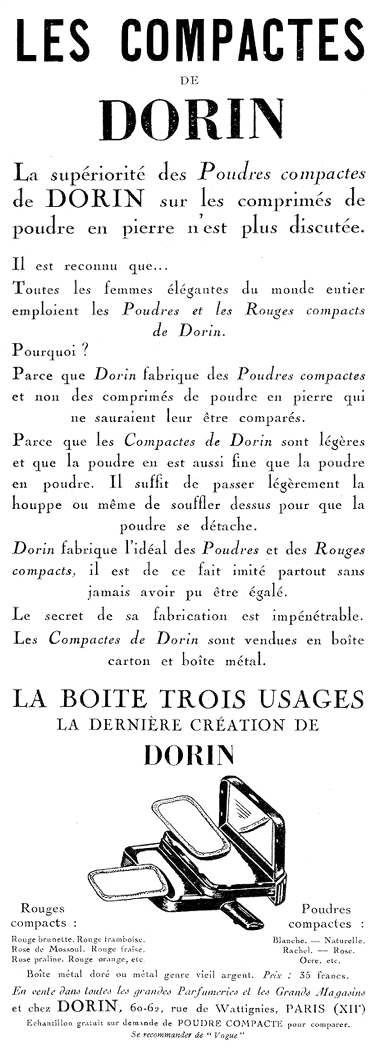
1930 Dorin Compact Powder and Rouge (France).
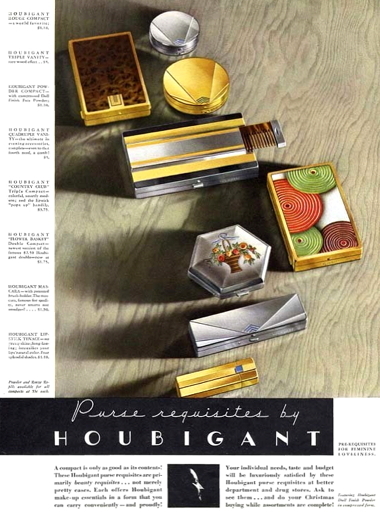
1934 A range of Houbigant compacts and other ‘Purse requisites’.
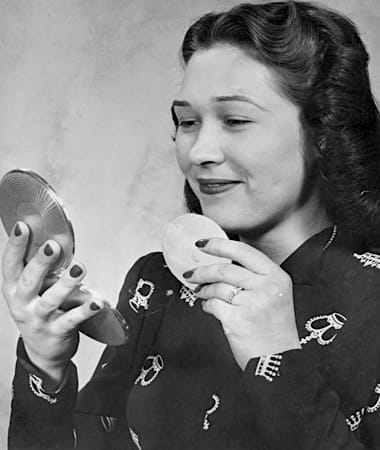
1947 Flapjack.
